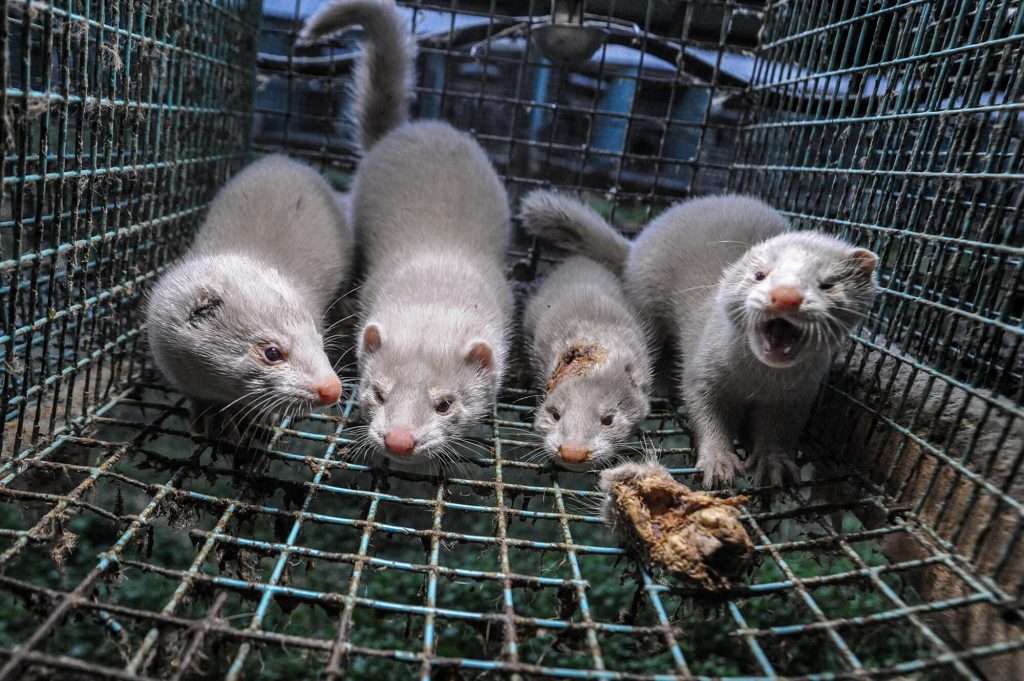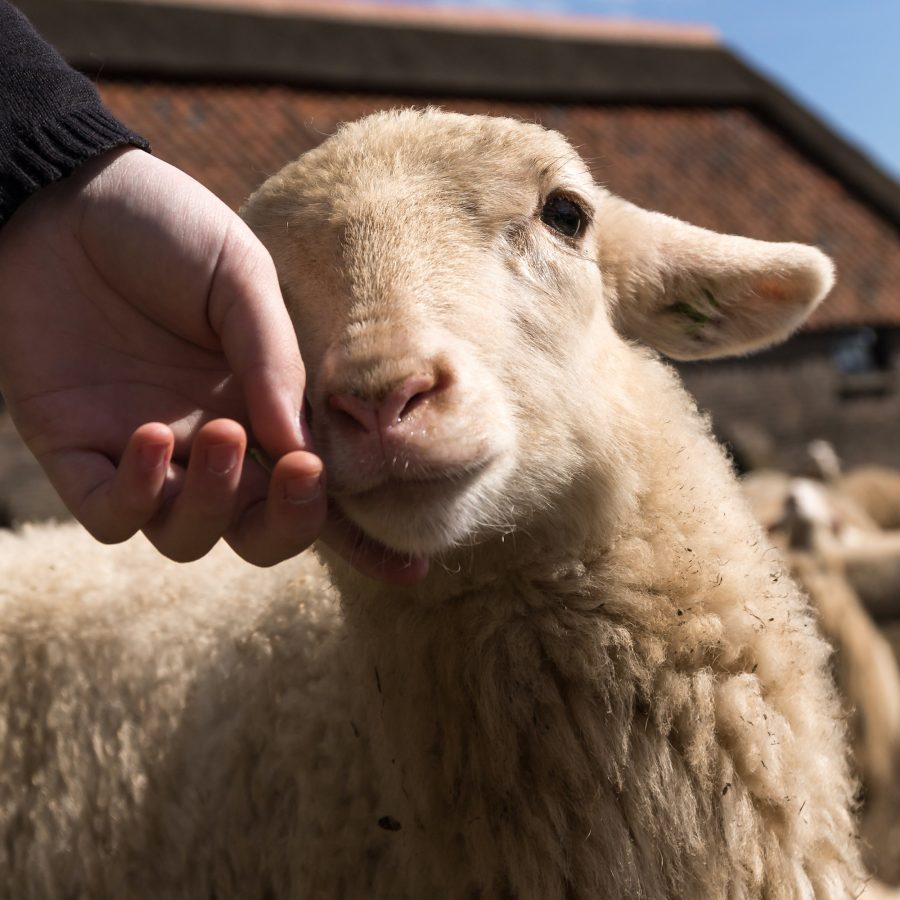Nowadays, an increasing number of designers are choosing not to use fur in their garments as a statement that they are against animal cruelty.
Despite the trend turning against fur over the past decades, each year well in excess of 50 million animals still suffer and die as victims of the international fur trade. This industry has turned to new tactics to sell its unnecessary product. By decorating coats and other fashion items with a fur ‘trim’ the fur industry has set yet another trap, this time for unwitting customers.
The victims
The list of animals suffering for fur production is long. Mink, foxes and rabbits are the most frequently bred, but also squirrels, badgers, wallabies, possums, racoons, beavers, lynxes, coyotes, seals, otters, bears, chinchillas, martens, bobcats, dogs and cats are killed for their fur. The number of animals that need to die for one fur coat varies from six to 12 for seals and lynxes, up to more than 100 for squirrels. Even for fur trim, mass production of these items equates to huge numbers of animals who suffer and die unnecessarily.
Fur factory farms
Eighty-five percent of the fur industry’s skins come from animals raised in ‘battery’ cages, where animals are deprived of any form of quality of life and the ability to perform their natural and instinctual behaviours. For example, in the wild mink live near streams and lakes where they swim, climb trees, make nests and hunt. Mink live solitary lives and are naturally very inquisitive animals.
On fur farms, they are forced to live their lives in small wire cages. The unsuitable living conditions cause chronic boredom and stress which lead to behavioural abnormalities such as running up and down their cages endlessly or twisting the head continuously. Zoologists at Oxford University found that despite generations of being bred for fur, mink have not been domesticated and suffer greatly in captivity, especially if they are not given the opportunity to swim.
Many fur bearing animals are solitary, so being cramped in a cage with others is particularly stressful. Their frustration and misery leads many animals to self-mutilate by biting their own tail or gnawing at their own limbs. After months of suffering, these animals are killed by electrocution, gassing or by breaking their necks. These methods are designed to avoid damage to the animals’ pelts but are inhumane and often carried out unprofessionally. In China, skinning animals alive is not uncommon.
Wildlife traps
The fur industry also employs wildlife traps to catch millions of wild animals. Traps, including steel-jaw leghold traps, body-gripping traps, underwater traps and wire neck snares, are cruel devices that inflict great and prolonged pain as they are either not designed to kill or fail to do so. Wildlife traps are not selective; they don’t discriminate between animal species. For every ‘wanted’ animal, another one to four so called ‘trash’ animals such as deer or birds, endangered animals and even domestic dogs and cats get trapped and often die an agonising, pointless death.
The most widely used trap is the leghold trap which consists of two spring-loaded jaws that slam onto the limb of an animal once they step on it. The jaws cut into the flesh, often down to the bone, leaving the animal to languish in pain for hours or even days until they die of their injuries or get killed by the hunter. Some animals gnaw off the trapped limb to free themselves, but have little chance to survive in the wild. Steel-Jaw leghold traps are banned in many countries, but still widely used to trap fur animals in the US, Canada and Russia.
Despite multi million dollar government funded research projects over decades to develop ‘humane’ traps that kill instantly, to date no such alternative has been found. These tests have only resulted in more animals suffering in experiments to measure the length of time before they die.
Dog and cat fur
Around 2 million dogs and cats are bred or taken from the street and killed in China each year for their fur. These animals are squeezed in tiny wire cages like sardines, sometimes transported for days without food or water, hanged, bled to death, beaten to death, strangled with wire nooses and regularly skinned alive. Many of the animals still have collars on, a sign that they were once someone’s beloved companions.
Australia, the EU and US have banned the import of dog and cat fur. But international investigations show that Chinese dog and cat fur is frequently mislabelled, for example as fox, rabbit or mink fur. Even accessories, trinkets and children toys have been found decorated with dog and cat fur.
Rabbit fur
A large proportion of fur used on lower cost items is from rabbits. Rabbits the world over are some of the animals least protected by animal welfare laws. China is one of the world’s largest producers of rabbits and, with no animal welfare laws, the caging, transport and killing methods of these animals is abysmal — whether for meat or fur. Conditions in other countries are not much better with even the European Union — normally considered a leader in animal welfare — not having species-specific legislation to protect the welfare of farmed rabbits.
Routinely, factory-farmed rabbits are crammed together in small and bare wire cages with little space to move. Bone disorders, foot abscesses and vertebral column deformations are common due to the inability to exercise and inadequate housing conditions. Rabbits suffer high levels of stress through being unable to perform natural behaviours.
Sometimes it is claimed that rabbit fur is a by-product from the rabbit meat industry, but this is rarely the case. Millions of rabbits are specifically bred and killed on factory farms for their fur because the rabbit fur industry demands the thicker pelt of an older animal for a particular quality fur. Rabbits raised for meat are killed too young, when they still have their unstable infant coats or have begun their subadult moult. Regardless, even in the rare case where the rabbits may have been raised for their meat and their furs are also used, they are reared and killed in similar inhumane ways.
It might come as a surprise, but even an iconic Australian brand uses rabbit fur to make its products: 12 rabbits are killed to make the felt for just one Akubra hat. The company has even admitted to importing rabbit pelts from the Ukraine and France to meet demand.
The environment
The fur industry is desperate to brand fur as a ‘natural’, ‘ecological’ and ‘environmentally friendly product’. This however is far from the truth. The manure produced by the intensive farming practices of millions of animals for fur cause an enormous strain on the environment. It pollutes soil and water and contributes to global warming.
On top of that many harmful chemicals are used in the processing of raw fur skins into clothes. Due to the chemicals used, fur is far from being a natural or ecological product. In fact it is not even biodegradable because of treatment to stop it from rotting. No wonder the European Fur Breeders Association’s “Why it’s eco-friendly to wear fur” advertisement was considered misleading and consequently banned by the Advertising Standards Authority in 2012.
A look inside a Chinese fur farm
China is the largest fur producer in the world. China also has very few laws to protect animals. Millions of rabbits, foxes, minks and racoons, suffer in the most extreme ways imaginable on Chinese fur farms, with some having their skins stripped off while they are still alive.







